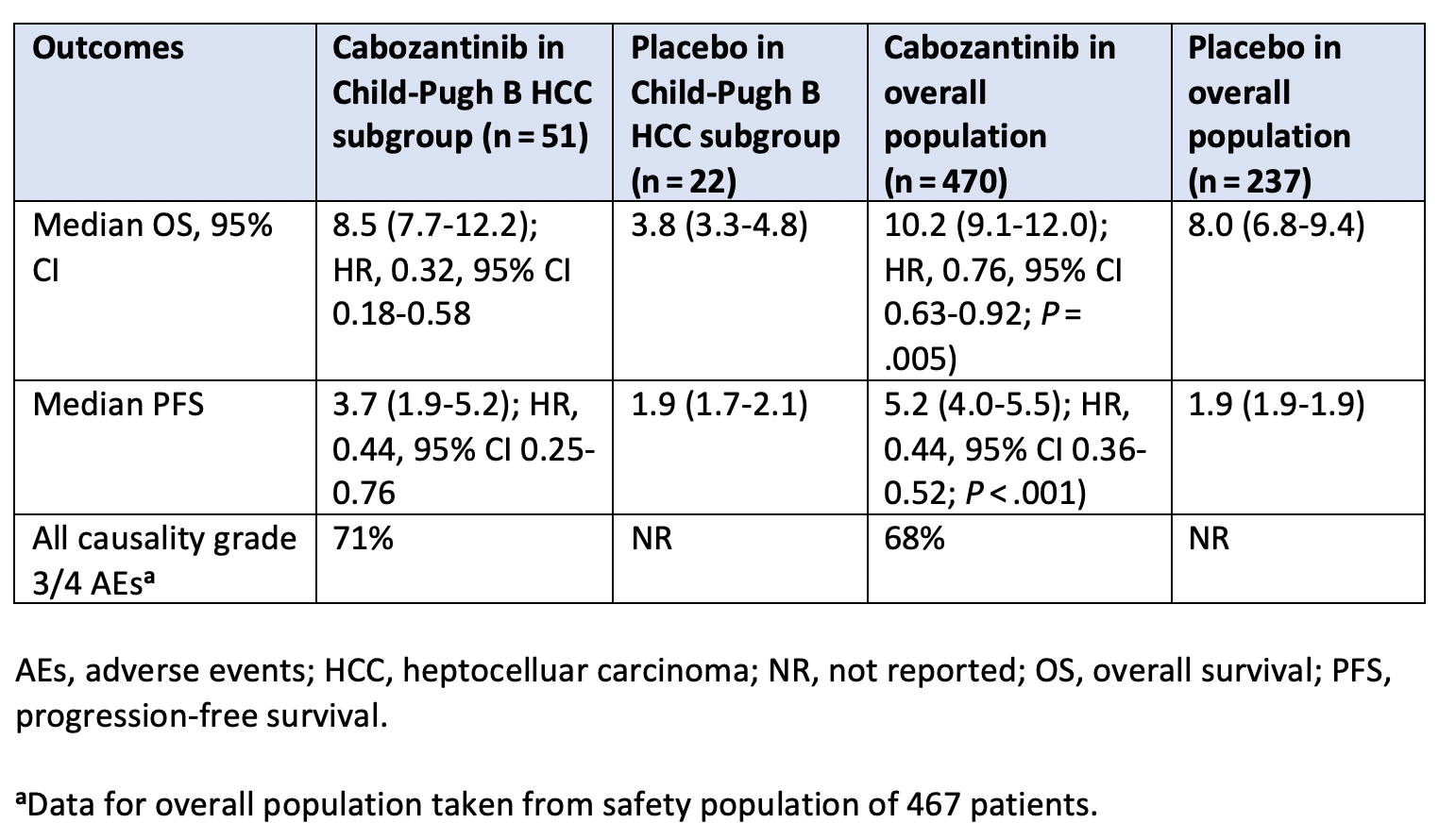Article
Cabozantinib Showcases Efficacy in Patients with HCC and Child-Pugh B
Author(s):
A retrospective analysis of data from the CELESTIAL trial has demonstrated the potential role for cabozantinib in patients with advanced hepatocellular carcinoma and Child-Pugh B liver cirrhosis.
Anthony B. El-Khoueiry, MD

A retrospective analysis of data from the CELESTIAL trial (NCT01908426) has demonstrated the potential role for cabozantinib (Cabometyx) in patients with advanced hepatocellular carcinoma (HCC) and Child-Pugh B liver cirrhosis. This subpopulation of patients is associated with poor prognosis due to advanced cirrhosis of the liver over the course of their disease, said Anthony B. El-Khoueiry, MD, who presented the data during the 2020 International Liver Cancer Association Virtual Conference.1
Outcomes evaluated in the retrospective analysis included 51 patients in the cabozantinib arm and 22 patients in the placebo arm who were Child-Pugh B in the study by week 8. Median overall survival (OS) from randomization was 8.5 months versus 3.8 months, respectively (HR, 0.32; 95% CI, 0.18-0.58). Further, the median progression-free survival (PFS) was 3.7 months versus 1.9 months (HR, 0.44; 95% CI, 0.25-0.76).
“Cabozantinib appears to have a manageable safety profile in this group of patients with comparable dose reduction and discontinuation rates to the overall population,” said El-Khoueiry, an associate professor of clinical medicine at the Keck School of Medicine of the University of Southern California (USC), medical director of Clinical Investigations Support Office at the USC Norris Comprehensive Cancer Center, and director of clinical translation at the Southern California Clinical and Translational Science Institute, all located in Los Angeles.
“The hazard ratios for OS [overall survival] and PFS [progression-free survival] suggest the presence of a clinical benefit in this subgroup [Table1],” he added.
Historically, patients with advanced HCC classified with Child-Pugh B are excluded from clinical trials due to an increased mortality rate of approximately 30% compared with 10% for those with Child-Pugh A classification as a result of liver failure.2 Though understudied in the initial enrollment population, cirrhosis may evolve over the course of treatment on trials for patients with advanced HCC.
Table. Clinical Efficacy of Cabozantinib in Patients with Child-Pugh B HCC1

Efficacy of Cabozantinib in Advanced HCC
A total of 707 patients with advanced HCC and Child-Pugh A cirrhosis who had received prior sorafenib (Nexavar) and progressed following treatment with at least 1 prior systemic regimen were randomized 2:1 to receive cabozantinib or placebo. Overall, 10.3% of patients (n = 73) experienced deterioration to Child-Pugh B cirrhosis in the first 8 weeks of the study period.1
“The deterioration from Child-Pugh A to Child-Pugh B at week 8 was mostly related to changes from baseline in albumin, bilirubin, and ascites,” El-Khoueiry said. “In the Child-Pugh B subgroup, patients in the cabozantinib arm versus in the placebo arm had higher rates of macrovascular invasion, extrahepatic spread, elevated alpha-fetoprotein [≥400 ng/mL], and more of the patients had hepatis B or C etiology for their liver disease.” These rates were, 43% versus 32%; 82% versus 68%; 39% versus 27%; 35% versus 27%; and 31% versus 18%, respectively.
Efficacy data in the overall population demonstrated a median OS in patients treated with cabozantinib (n = 470) was 10.2 months (95% CI 9.1-12.0) versus 8.0 months (95% CI, 6.8-9.4) in those treated in the placebo arm (n = 237; HR, 0.76; 95% CI, 0.63-0.92; P = .005). The median PFS was 5.2 months (95% CI, 4.0-5.5) compared with 1.9 months (95% CI, 1.9-1.9), respectively (HR, 0.44; 95% CI, 0.36-0.52; P < .001).
Safety of Cabozantinib in Advanced HCC
“In this subgroup of patients who deteriorated from Child-Pugh A to Child-Pugh B by week 8 [compared with the overall population] we see that they had a similar median duration of exposure to cabozantinib, and they had a similar median average daily dose,” El-Khoueiry said. The median duration of exposure was 3.7 months versus 3.8 months and the median average daily doses were 36.9 mg versus 35.8 mg, respectively.
Of those patients treated with cabozantinib, the rates of dose reductions were similar in the Child-Pugh B subgroup (n = 51) and in the safety population of the overall study group (n = 467) with 61% and 62% of patients seeking a lower dose of cabozantinib, respectively.
Both populations also experienced a similar rate of discontinuation due to treatment-related AEs (18% vs 16%). The most common grade 3/4 AEs in the cabozantinib-treated Child-Pugh B subgroup versus the overall population were fatigue (20% vs 10%), ascites (14% vs 4%), aspartate aminotransferase increase (14% vs 12%), and thrombocytopenia (12% vs 3%). Notably, the subgroup experienced lower rates of grade 3/4 palmer-planter erythrodysesthesia (8% vs 17%) and hypertension (8% vs 16%) than the overall population.
“Further prospective studies are warranted in [patients with] Child-Pugh B with HCC, as this is a population with considerable unmet need,” El-Khoueriy concluded. The safety and efficacy of cabozantinib are being evaluated further in a phase 1/2 trial (NCT04497038) for the treatment of patients with unresectable or metastatic HCC with underlying Child-Pugh B cirrhosis who have either progressed or were deemed intolerant of first-line systemic therapy.
References
- El-Khoueriry AB, Meyer T, Cheng AL, et al. Outcomes for patients with advanced hepatocellular carcinoma and Child-Pugh B liver function in the phase 3 celestial study of cabozantinib versus placebo. Presented at: 2020 International Liver Cancer Association Virtual Conference; September 11-13, 2020; virtual. Abstract 0-24.
- Tsoris A, Martar CA. Use of the Child Pugh Score in liver disease. In: Abai B, Abu-Ghosh A, Acharya, AB, et al. StatPearls. Treasure Island, Florida: StatPearls Publishing; 2020.Updated May 17, 2020. Accessed September 11, 2020. https://www.ncbi.nlm.nih.gov/books/NBK542308/









